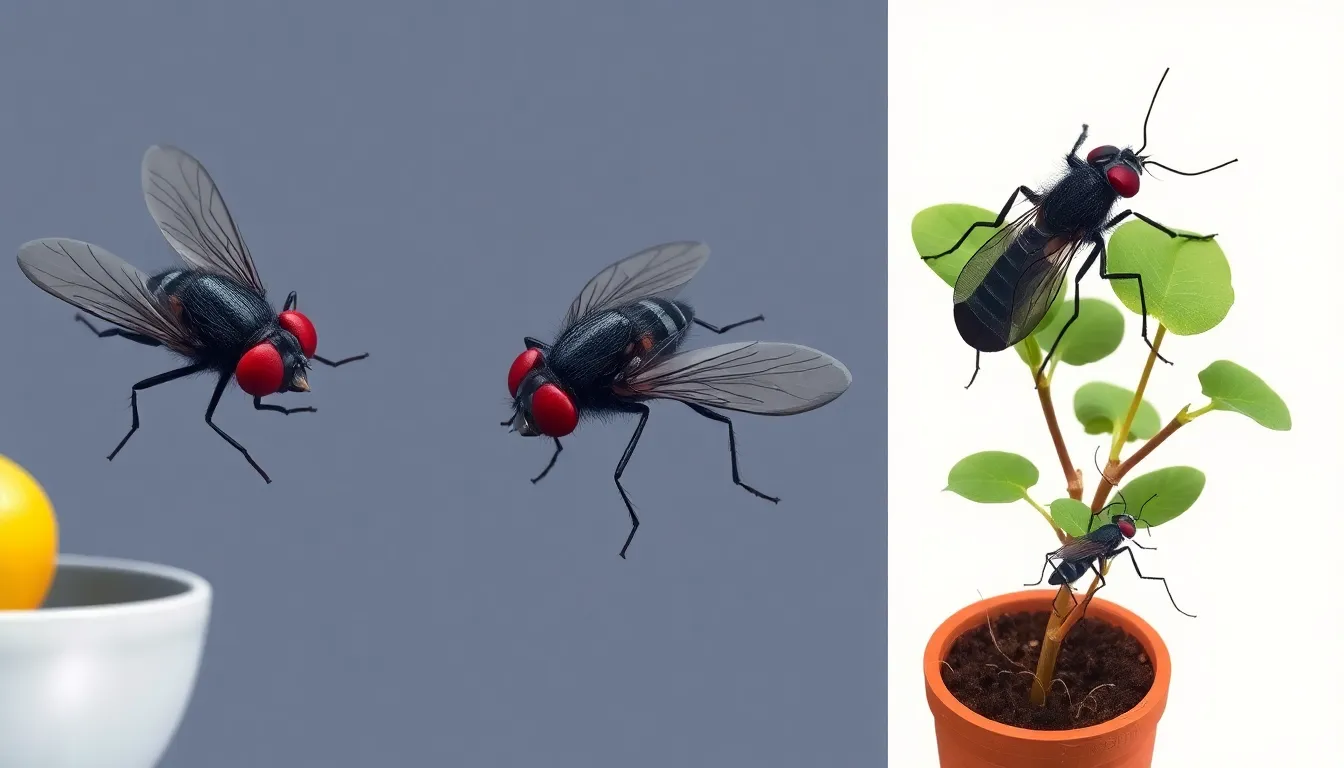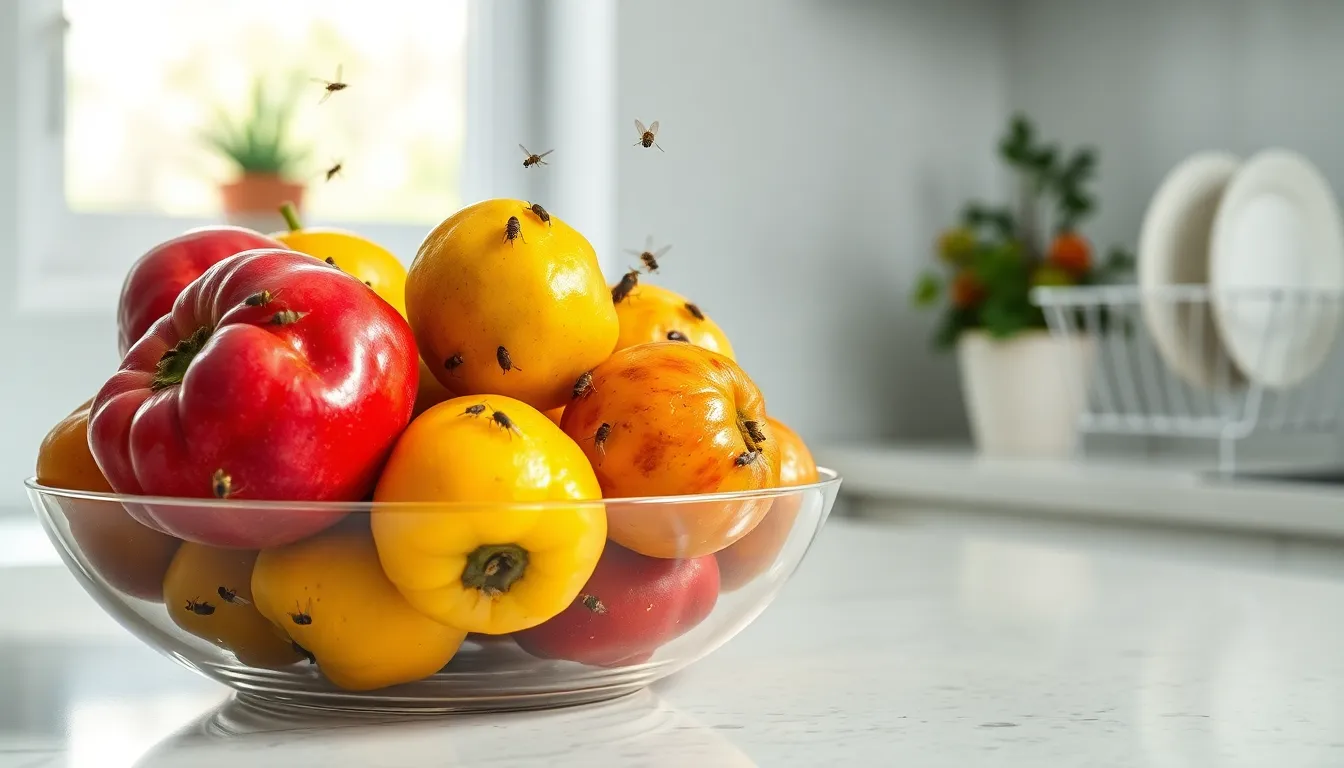Small black flies buzzing around the house can feel like an unwelcome party crasher. They swoop in uninvited, making themselves at home and turning your peaceful abode into a buzzing battleground. But don’t worry, these tiny pests aren’t just here to annoy you; they often signal something more significant lurking in the shadows of your home.
Table of Contents
ToggleOverview of Small Black Flies in House
Small black flies commonly infest houses, causing irritation for residents. These pests often appear in kitchens and bathrooms, targeting moisture-rich areas. Identification is crucial, as various species resemble one another. Fruit flies, drain flies, and fungus gnats frequently contribute to these pesky invasions.
Fruit flies typically thrive around ripening fruits and vegetables. They can also reproduce rapidly, laying hundreds of eggs at a time. Drain flies, on the other hand, prefer stagnant water and organic matter found in drains. Their presence indicates that sanitation issues may exist within plumbing systems.
Fungus gnats often emerge from houseplants, especially those kept overly moist. They feed on decaying organic materials, making plant care essential for prevention. Monitoring water levels and plant health helps manage these flies effectively.
Ignoring small black flies might lead to larger infestations. Each species has unique behaviors and life cycles, resulting in distinct challenges for homeowners. Actively addressing the root causes reduces attractants, making environments less hospitable for these insects.
Implementing sanitation practices is vital. Regularly cleaning kitchen surfaces, disposing of food scraps, and maintaining proper drainage prevents fly breeding grounds. Furthermore, checking indoor plants for excess moisture and rot can minimize the risk of fungus gnats.
Proactive household management creates an inhospitable environment for these nuisances. By understanding their behaviors and habitats, homeowners can effectively deter small black flies and maintain a serene living space.
Common Types of Small Black Flies

Identifying small black flies is essential for effective management. Various types infest homes, including fruit flies, drain flies, and fungus gnats.
Description and Identification
Fruit flies measure about 1/8 inch long, typically featuring red eyes and a tan body. They often swarm around overripe fruit and fermenting materials. Drain flies appear slightly larger, around 1/4 inch, with fuzzy bodies resembling miniature moths. Their presence in or near drains is indicative of a breeding ground. Fungus gnats, smaller at 1/16 inch, possess long legs and delicate wings, making them appear like tiny mosquitoes. They often hover around damp houseplants.
Breeding Habits
Fruit flies reproduce rapidly, capable of laying hundreds of eggs on rotting fruit within a week. Drain flies breed in stagnant water, so clogged pipes or dirty drains provide ideal breeding sites. Fungus gnats thrive in moist soil, where they lay their eggs near decaying organic matter. A few days after hatching, larvae begin feeding on the roots of houseplants, which can harm plant health. Each fly type’s unique breeding habits suggest specific areas for focused pest control efforts.
Causes of Infestation
Small black flies often invade homes due to specific factors that attract them. Recognizing these causes helps homeowners mitigate infestations effectively.
Sources of Attraction
Overripe fruits attract fruit flies due to their ripe scent and sugary residues. Dirty dishes left unattended provide a food source for various small flies. Similarly, crumbs or spills on countertops invite these pests, fueling their presence. Houseplants with decaying leaves create an ideal breeding ground for fungus gnats. Additionally, improperly sealed garbage cans emit odors that lure in flies.
Environmental Factors
Moisture-rich environments significantly contribute to fly infestations. Clogged drains and standing water in sinks foster habitats for drain flies. High humidity levels in bathrooms and kitchens support the breeding of small black flies. Soil that remains overly wet in potted plants encourages fungus gnats to thrive. Lastly, poor sanitation practices around the home can lead to increased populations of these unwelcome visitors.
Effective Control Methods
Small black flies require effective control methods to eliminate their presence in homes. Addressing the issue involves employing both natural remedies and chemical solutions for optimal results.
Natural Remedies
Natural remedies offer safe options for controlling small black flies. Vinegar traps attract and capture fruit flies effectively. Mixing apple cider vinegar with dish soap creates a potent lure; fruit flies get trapped as they approach the surface. Essential oils like peppermint, eucalyptus, and lemon can deter flies and other pests. Diluting the oils in water and spraying on affected areas repels these nuisances. For fungus gnats, using a soil drench made from beneficial nematodes targets larvae in damp soil. Maintaining cleanliness and removing overripe fruits or organic debris reduces breeding grounds significantly.
Chemical Solutions
Chemical solutions provide more immediate results against small black flies. Insecticides labeled for flies effectively kill adult pests and larvae. Products containing pyrethrins act quickly and are safe for indoor use when applied correctly. Residual sprays can help in areas prone to infestations, like kitchens and bathrooms. Bait stations designed specifically for fruit flies also prove useful; these attract and eliminate them with minimal effort. Caution is essential when using chemical treatments, as they may pose risks to pets and humans. Always read labels for proper usage and safety information.
Preventative Measures
Implementing preventative measures helps homeowners minimize the risk of small black flies in their living spaces.
Home Maintenance Tips
Keep kitchens and bathrooms clean to deter small black flies. Regularly wash dishes and wipe down surfaces to eliminate food residue. Check for leaks or stagnant water, as these attract drain flies. Maintaining dry conditions around houseplants also proves essential. Properly sealing garbage cans prevents access to food sources, while timely disposal of overripe fruits reduces breeding grounds for fruit flies. Addressing clutter ensures that debris doesn’t accumulate, which further discourages infestations. Monitoring humidity levels enhances indoor air quality and limits favorable conditions for these pests.
Seasonal Precautions
Taking seasonal precautions helps curb small black flies throughout the year. During warmer months, inspect windows and doors for gaps that might allow insects entry. Cleaning gutters prevents water accumulation, a common habitat for flies. Fall cleaning can include removing decaying leaves and organic matter to eliminate potential breeding sites. Winter usually brings indoor activities, so vigilance with houseplants becomes critical, ensuring soil isn’t overly moist. Additionally, using screens on windows and doors can act as a barrier against these unwelcome guests during milder temperatures. Proper seasonal care reinforces a fly-free home environment.
Small black flies can quickly become a frustrating presence in any home. Identifying the type of fly is essential for effective control and prevention. By addressing the underlying causes of infestations and maintaining a clean environment, homeowners can significantly reduce the likelihood of these pests returning. Implementing natural remedies and chemical solutions can provide immediate relief while ongoing maintenance ensures a long-term strategy for a fly-free space. With diligence and the right approach, it’s possible to reclaim peace and comfort in the home.








